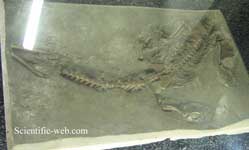
| Nothosaurus Fossil range: Early to Late Triassic |
||||||||||||
|---|---|---|---|---|---|---|---|---|---|---|---|---|
| Scientific classification | ||||||||||||
|
||||||||||||
| Species | ||||||||||||
|
Nothosaurus is an extinct genus of sauropterygian reptile from the Triassic period, approximately 240-210 million years ago, with fossils being distributed from North Africa and Europe to China. It was about 4 m (13ft) long and is the best known member of the nothosaur order. Its name means False lizard.
Description
Nothosaurus was a semi-oceanic animal which probably had a lifestyle similar to that of today's seals. It had long, webbed toes and possibly a fin on its tail. When swimming, Nothosaurus would use its tail, legs, and webbed feet to propel and steer it through the water. The skull was broad and flat,with long jaws, lined with needle teeth, it probably caught fish and other marine creatures. Nothosaurus hunted by sneaking up slowly on prey, such as shoals of small fish, the putting on a last-minute burst of speed. Once caught, few animals would be able to shake themselves free from the mouth of Nothosaurus.
Nothosaurus skeleton in Berlin.
In many respects its body structure resembled that of the much later plesiosaurs, but it did not attain the plesiosaurs' high degree of adaptation to an aquatic environment. A complete skeleton of the species Nothosaurus raabi can be seen in the Natural History Museum in Berlin. It is though that one branch of the nothosaurs evolved into plesiosaurs such as Liopleurodon and the long-necked Cryptoclidus.
In Popular Culture
In the Rite of Spring segment of Disney's Fantasia, Nothosaurus is briefly depicted; feeding its young and as the anachronistic prey of Dimetrodon.
Nothosaurus was featured in the 2003 BBC series Sea Monsters, a spin-off of the successful Walking with Dinosaurs (1999). It was featured as a minor character that Nigel Marven kept at bay with an electric tazer.
References
Dixon, Dougal (2006). The Complete Book of Dinosaurs. Hermes House.
Haines, Tim, and Paul Chambers. The Complete Guide to Prehistoric Life. Pg. 64. Canada: Firefly Books Ltd., 2006
Retrieved from "http://en.wikipedia.org/"
All text is available under the terms of the GNU Free Documentation License

